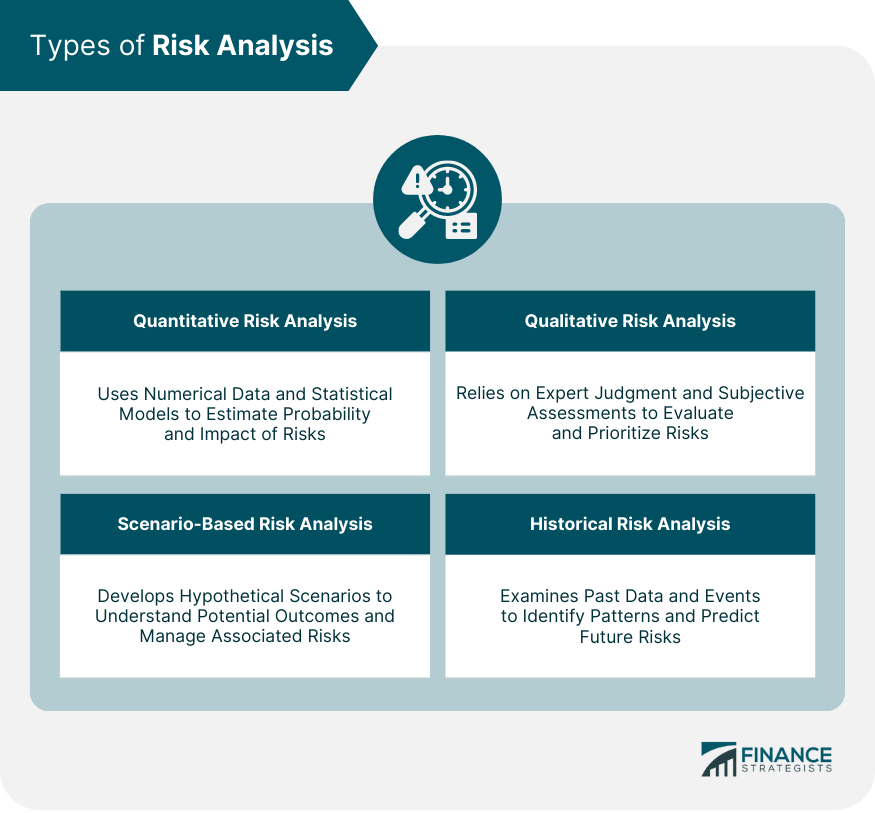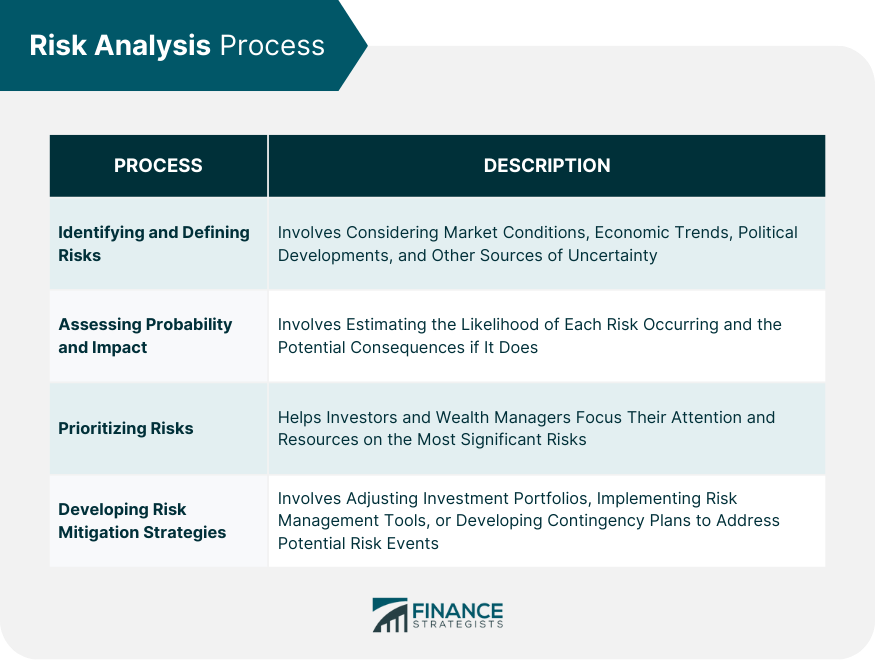Risk analysis is the process of identifying, assessing, and prioritizing potential risks and uncertainties that may impact the performance of investments, projects, or other activities. It involves evaluating the likelihood and potential consequences of these risks, as well as developing strategies to manage or mitigate their impact. In wealth management, risk analysis plays a crucial role in helping investors and financial advisors make informed decisions about their investment portfolios. By understanding the risks associated with various assets and investment strategies, wealth managers can develop plans to minimize potential losses, optimize returns, and protect their clients' financial well-being. Risk analysis and risk assessment are often used interchangeably, but they have distinct meanings. Risk analysis refers to the process of evaluating and prioritizing risks, while risk assessment is a broader term that encompasses the entire process of identifying, analyzing, and managing risks. Risk assessment includes the steps of risk identification, risk analysis, and risk mitigation, while risk analysis focuses specifically on the evaluation of the likelihood and potential impact of identified risks. Quantitative risk analysis involves the use of numerical data and statistical models to estimate the probability and potential impact of risks. This type of risk analysis provides a more objective and precise assessment of risk, allowing for better-informed decision-making and risk management. Qualitative risk analysis, on the other hand, relies on expert judgment, experience, and subjective assessments to evaluate and prioritize risks. This approach is particularly useful when numerical data is limited or unavailable, or when the risks being assessed are complex and difficult to quantify. Scenario-based risk analysis involves the development of hypothetical scenarios that represent different potential outcomes or risk events. By evaluating the potential impact of each scenario, investors and wealth managers can better understand the range of possible outcomes and develop strategies to manage or mitigate the associated risks. Historical risk analysis examines past data and events to identify patterns and trends that may help predict future risks. This type of risk analysis can provide valuable insights into the potential impact of similar events or conditions on current investments and financial plans. The first step in the risk analysis process is to identify and define the potential risks that may impact an investment or financial plan. This involves considering a wide range of factors, including market conditions, economic trends, political developments, and other sources of uncertainty. Once risks have been identified, the next step is to assess their probability and potential impact. This involves estimating the likelihood of each risk occurring and the potential consequences if it does. Both quantitative and qualitative methods can be used to evaluate probability and impact, depending on the nature of the risks and the available data. After assessing the probability and impact of each risk, the next step is to prioritize them based on their potential consequences and the likelihood of occurrence. This process helps investors and wealth managers focus their attention and resources on the most significant risks, allowing for more efficient and effective risk management. The final step in the risk analysis process is to develop strategies to manage or mitigate the prioritized risks. This may involve adjusting investment portfolios, implementing risk management tools, or developing contingency plans to address potential risk events. Statistical models are widely used in quantitative risk analysis to estimate the probability and potential impact of risks. These models often rely on historical data and statistical techniques to identify patterns and trends that can help predict future risks. Scenario analysis is a tool used in both quantitative and qualitative risk analysis to evaluate the potential impact of different hypothetical scenarios. This technique can help investors and wealth managers understand the range of possible outcomes and develop strategies to manage the associated risks. Sensitivity analysis involves examining how changes in various input factors can affect the outcome of an investment or financial plan. This technique can help identify potential risks and inform decision-making by revealing the factors that have the greatest impact on outcomes. Stress testing is a technique used to evaluate the resilience of an investment or financial plan under extreme or adverse conditions. By simulating these conditions and assessing the potential impact on the investment or plan, stress testing can provide valuable insights into the robustness of risk management strategies and the overall financial stability of the portfolio. Risk analysis is the process of evaluating and prioritizing potential risks and uncertainties that may impact the performance of investments, projects, or other activities. Types of risk analysis include quantitative, qualitative, scenario-based, and historical risk analysis. The risk analysis process involves identifying and defining risks, assessing probability and impact, prioritizing risks, and developing risk mitigation strategies. Risk analysis plays a crucial role in wealth management, helping investors and financial advisors make informed decisions about their investment portfolios and develop strategies to minimize potential losses, optimize returns, and protect their clients' financial well-being.What Is Risk Analysis?
Risk Analysis vs Risk Assessment
Types of Risk Analysis
Quantitative Risk Analysis
Qualitative Risk Analysis
Scenario-Based Risk Analysis
Historical Risk Analysis

Risk Analysis Process
Identifying and Defining Risks
Assessing Probability and Impact
Prioritizing Risks
Developing Risk Mitigation Strategies

Tools and Techniques for Risk Analysis
Statistical Models
Scenario Analysis
Sensitivity Analysis
Stress Testing
Final Thoughts
Risk Analysis FAQs
The main purpose of risk analysis in wealth management is to identify, assess, and prioritize potential risks that may impact the performance of investments. It helps investors and financial advisors make informed decisions about their investment portfolios, develop strategies to minimize potential losses, optimize returns, and protect their clients' financial well-being.
Risk analysis and risk assessment are related but distinct concepts. Risk analysis refers specifically to the evaluation of the likelihood and potential impact of identified risks, while risk assessment is a broader term that encompasses the entire process of identifying, analyzing, and managing risks.
The types of risk analysis include quantitative risk analysis, qualitative risk analysis, scenario-based risk analysis, and historical risk analysis.
Some common tools and techniques used in risk analysis include statistical models, scenario analysis, sensitivity analysis, and stress testing.
Prioritizing risks during the risk analysis process is important because it helps investors and wealth managers focus their attention and resources on the most significant risks. This allows for more efficient and effective risk management, ultimately protecting clients' financial well-being and optimizing returns.
True Tamplin is a published author, public speaker, CEO of UpDigital, and founder of Finance Strategists.
True is a Certified Educator in Personal Finance (CEPF®), author of The Handy Financial Ratios Guide, a member of the Society for Advancing Business Editing and Writing, contributes to his financial education site, Finance Strategists, and has spoken to various financial communities such as the CFA Institute, as well as university students like his Alma mater, Biola University, where he received a bachelor of science in business and data analytics.
To learn more about True, visit his personal website or view his author profiles on Amazon, Nasdaq and Forbes.











